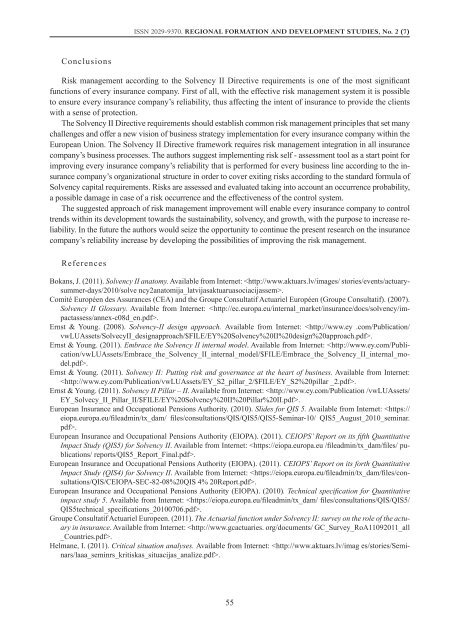regional formation and development studies - KlaipÄdos universitetas
regional formation and development studies - KlaipÄdos universitetas
regional formation and development studies - KlaipÄdos universitetas
Create successful ePaper yourself
Turn your PDF publications into a flip-book with our unique Google optimized e-Paper software.
ISSN 2029-9370. Regional Formation <strong>and</strong> Development Studies, No. 2 (7)<br />
Conclusions<br />
Risk management according to the Solvency II Directive requirements is one of the most significant<br />
functions of every insurance company. First of all, with the effective risk management system it is possible<br />
to ensure every insurance company’s reliability, thus affecting the intent of insurance to provide the clients<br />
with a sense of protection.<br />
The Solvency II Directive requirements should establish common risk management principles that set many<br />
challenges <strong>and</strong> offer a new vision of business strategy implementation for every insurance company within the<br />
European Union. The Solvency II Directive framework requires risk management integration in all insurance<br />
company’s business processes. The authors suggest implementing risk self - assessment tool as a start point for<br />
improving every insurance company’s reliability that is performed for every business line according to the insurance<br />
company’s organizational structure in order to cover exiting risks according to the st<strong>and</strong>ard formula of<br />
Solvency capital requirements. Risks are assessed <strong>and</strong> evaluated taking into account an occurrence probability,<br />
a possible damage in case of a risk occurrence <strong>and</strong> the effectiveness of the control system.<br />
The suggested approach of risk management improvement will enable every insurance company to control<br />
trends within its <strong>development</strong> towards the sustainability, solvency, <strong>and</strong> growth, with the purpose to increase reliability.<br />
In the future the authors would seize the opportunity to continue the present research on the insurance<br />
company’s reliability increase by developing the possibilities of improving the risk management.<br />
References<br />
Bokans, J. (2011). Solvency II anatomy. Available from Internet: .<br />
Comité Européen des Assurances (CEA) <strong>and</strong> the Groupe Consultatif Actuariel Européen (Groupe Consultatif). (2007).<br />
Solvency II Glossary. Available from Internet: .<br />
Ernst & Young. (2008). Solvency-II design approach. Available from Internet: .<br />
Ernst & Young. (2011). Embrace the Solvency II internal model. Available from Internet: .<br />
Ernst & Young. (2011). Solvency II: Putting risk <strong>and</strong> governance at the heart of business. Available from Internet:<br />
.<br />
Ernst & Young. (2011). Solvency II Pillar – II. Available from Internet: .<br />
European Insurance <strong>and</strong> Occupational Pensions Authority. (2010). Slides for QIS 5. Available from Internet: .<br />
European Insurance <strong>and</strong> Occupational Pensions Authority (EIOPA). (2011). CEIOPS’ Report on its fifth Quantitative<br />
Impact Study (QIS5) for Solvency II. Available from Internet: .<br />
European Insurance <strong>and</strong> Occupational Pensions Authority (EIOPA). (2011). CEIOPS’ Report on its forth Quantitative<br />
Impact Study (QIS4) for Solvency II. Available from Internet: .<br />
European Insurance <strong>and</strong> Occupational Pensions Authority (EIOPA). (2010). Technical specification for Quantitative<br />
impact study 5. Available from Internet: .<br />
Groupe Consultatif Actuariel Europeen. (2011). The Actuarial function under Solvency II: survey on the role of the actuary<br />
in insurance. Available from Internet: .<br />
Helmane, I. (2011). Critical situation analyses. Available from Internet: .<br />
55

















